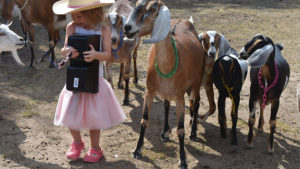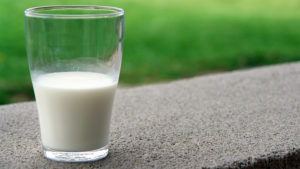
Dairy Goats and Humans
Goats and sheep are humankind’s oldest domesticated species dating back some 10,000 years. For thousands of years, goats have been used for their milk, meat, hair, and skins over much of the world. In the last century they have also gained popularity as pets, pack animals, brush control for fire reduction and vegetation control for cities and communities in general.
 An ideal family dairy animal, the dairy goat is easily handled and can be kept on small parcels of land. The dairy goat’s appeal to young people is evidenced by the numerous dairy goat projects in the 4-H and FFA programs. It is alert, intelligent, socially inclined and affectionate. A loving and loved animal, it returns the cost of its feed in a valuable and healthful food product. Its delicious milk is wholesome and nutritious.
An ideal family dairy animal, the dairy goat is easily handled and can be kept on small parcels of land. The dairy goat’s appeal to young people is evidenced by the numerous dairy goat projects in the 4-H and FFA programs. It is alert, intelligent, socially inclined and affectionate. A loving and loved animal, it returns the cost of its feed in a valuable and healthful food product. Its delicious milk is wholesome and nutritious.
An aspect of the dairy goat industry that is steadily increasing is the modern commercial dairy. Goat milk is fresh, raw or pasteurized, condensed and dried. Grocery stores and specialty shops offer gourmet cheese and ice creams made of goat milk, as well as body care products such as soaps and lotions.
Not all goats can be registered. There are specific breeds which are considered most productive for milk production. Within those breeds there are specific criteria for breed conformation and parentage verification to be included in the registry for that breed. Registration is important documentation that verifies a goat is actually what it appears to be. See Dairy Goat Breed Standards
Dairy Goat Products
 There is no perceptible difference between the flavor of properly handled goat milk and that of cow milk. Goat milk is whiter than whole cow milk. Butter and cheese made from goat milk are also white, but may be colored during processing.
There is no perceptible difference between the flavor of properly handled goat milk and that of cow milk. Goat milk is whiter than whole cow milk. Butter and cheese made from goat milk are also white, but may be colored during processing.
Goat milk is delicious, nutritious and wholesome. It may not be a miracle food, but it does have distinct characteristics that make it beneficial. The fat globules are smaller than those in cow milk and the curd is softer and smaller, making the digestion easier. Those who are allergic to cow milk may tolerate and thrive on goat milk.
Goat milk is used for drinking, cooking and baking. It is used to make cheese, butter, ice cream, yogurt and body products. Goat milk is naturally emulsified. Cream does not rise readily, but can be obtained with a mechanical separator.
The meat of the goat is chevon or cabrito. It can be barbecued, baked, fried, broiled or stewed. Goat leather is soft and fine grained when well cured. It is used to make many kinds of quality leather items. The dairy goat’s pelleted droppings make an excellent organic fertilizer.
Dairy Goat Milk Comparison
| Goat | Cow | Human | |
|---|---|---|---|
| Protein % | 3.0 | 3.0 | 1.1 |
| Fat % | 3.8 | 3.6 | 4.0 |
| Calories/100 ml | 70 | 69 | 68 |
| Vitamin A (i.u./gram fat) | 39 | 21 | 32 |
| Vitamin B1/thiamin (µg/100 ml) | 68 | 45 | 17 |
| Riboflavin (µg/100 ml) | 210 | 159 | 26 |
| Vitamin C (mg ascorbic acid/100 ml) | 2 | 2 | 3 |
| Vitamin D (i.u./gram fat) | 0.7 | 0.7 | 0.3 |
| Calcium % | 0.19 | 0.18 | 0.04 |
| Iron % | 0.07 | 0.06 | 0.2 |
| Phosphorus % | 0.27 | 0.23 | 0.06 |
| Cholesterol (mg/100 ml) | 12 | 15 | 20 |
Request a Free Dairy Goat Information Packet
Would you like to know more about how dairy goats and participation in the American Dairy Goat Association would benefit you? Request a free information packet today. Contact Us >>
